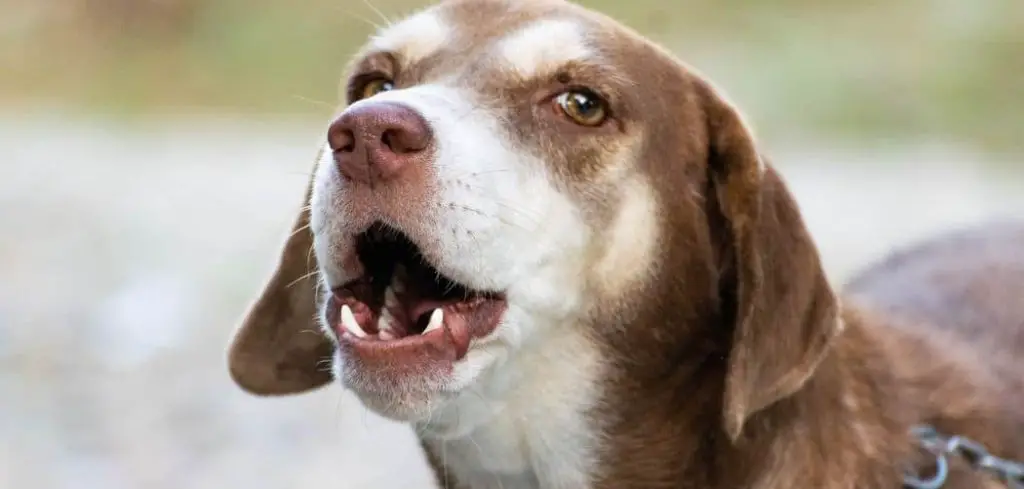Welcoming a new puppy into a home with a senior dog can be stressful, especially when the older dog starts growling.
Growling is a form of communication that often signals discomfort, fear, or a desire to assert boundaries.
We outline the common reasons for an old dog growling at a new puppy, what you can do at home, and when to seek veterinary help.
Old Dog Growling at New Puppy — Why It Happens
An old dog growling at a new puppy is usually a normal response and often linked to setting boundaries rather than outright aggression. Older dogs may feel protective of their space, food, toys, or their humans, and the sudden energy of a playful puppy can overwhelm them.
Behavioral factors such as socialization history and personality differences between the older dog and new puppy also contribute.
Growling is a form of communication—it’s the older dog’s way of teaching the puppy limits and acceptable behavior. In many cases, this helps the puppy learn social skills.
However, if the growling escalates into snapping or persistent aggression, it could signal stress, health issues, or difficulty adjusting, and you may need to step in with gentle training or consult a veterinarian or trainer.

Old Dog Growling at New Puppy: Common Causes
Territorial Behavior
Older dogs often feel protective of their home and possessions. A new puppy may trigger a sense of territoriality, leading to growling when the puppy approaches favored spaces, toys, or beds.
You might notice stiff body posture, lunging, or blocking behavior. Managing territory with separate areas for each dog can help reduce stress and potential conflict.
Read more: Old Dog Panting a Lot (Here’s why)
Pain or Discomfort
Physical discomfort or chronic pain is common in senior dogs.
An old dog experiencing arthritis, dental issues, or other health problems may growl when the puppy’s playful behavior becomes overwhelming.
Signs include limping, reluctance to move, or sensitivity when touched. Ensuring the older dog’s comfort and addressing health concerns can reduce irritation and defensive behavior.
Fear or Anxiety
A new puppy can be intimidating to an older dog, especially if the puppy is energetic or persistent.
Fear-based growling occurs when the senior dog feels cornered or unable to escape. Symptoms include cowering, retreating, or sudden barking. Gradual introductions and safe spaces for the older dog can ease anxiety and promote positive interactions.
Resource Guarding
Some older dogs guard food, toys, or resting areas more strongly than younger dogs.
A puppy approaching these resources may trigger growling to assert ownership. Observing when and where growling occurs can help identify triggers.
Separating resources and training both dogs to respect boundaries is critical to prevent escalation.
Cognitive Changes
Cognitive decline, or canine dementia, can affect behavior in older dogs.
Disorientation, confusion, or sudden changes in routine may make an older dog more reactive or irritable toward a new puppy.
Signs include disrupted sleep, aimless pacing, or altered social interactions. Providing structure, mental stimulation, and veterinary evaluation for cognitive changes can improve behavior.
Socialization and Personality Differences
Individual personality differences and socialization history influence interactions with a new puppy.
An older dog that was not exposed to young, energetic dogs may feel threatened or overwhelmed.
Growling may simply reflect the dog’s attempt to communicate limits. Controlled, supervised interactions and positive reinforcement can help both dogs adapt.
What to Do If Your Old Dog Is Growling at Your New Puppy
Supervise all interactions between your senior dog and new puppy. Never leave them alone until you are confident they can interact safely.
Provide separate spaces for each dog, including beds, feeding areas, and toys, to reduce territorial stress.
Use positive reinforcement to reward calm, non-aggressive behavior around the puppy. Avoid punishment, which can increase fear or aggression.
Ensure your old dog’s physical health is addressed, including pain management, dental care, and mobility support, to reduce irritability.
Introduce the puppy gradually, allowing the older dog to approach at their own pace, and provide consistent routines to promote security and predictability.
When to Call or Visit Your Vet
Seek veterinary advice if your older dog displays sudden or escalating aggression toward the puppy.
Growling accompanied by snapping, biting, or defensive lunging should be addressed promptly to prevent injury.
Changes in appetite, sleep patterns, or other signs of stress may indicate underlying health issues that exacerbate aggressive behavior.
A veterinarian or veterinary behaviorist can assess both medical and behavioral factors and guide a tailored management plan.
Read more: Old Dog Face Twitching (Here’s Why)
Key Takeaway
Growling in an old dog toward a new puppy is often a combination of territorial instincts, fear, discomfort, or cognitive changes.
Careful observation, gradual introductions, separate resources, and positive reinforcement are key to reducing tension.
Addressing underlying health issues and consulting professionals when needed can create a safe, happy environment for both dogs.
With patience, empathy, and proactive management, your older dog and new puppy can learn to coexist peacefully, ensuring both feel secure and valued in their shared home.
